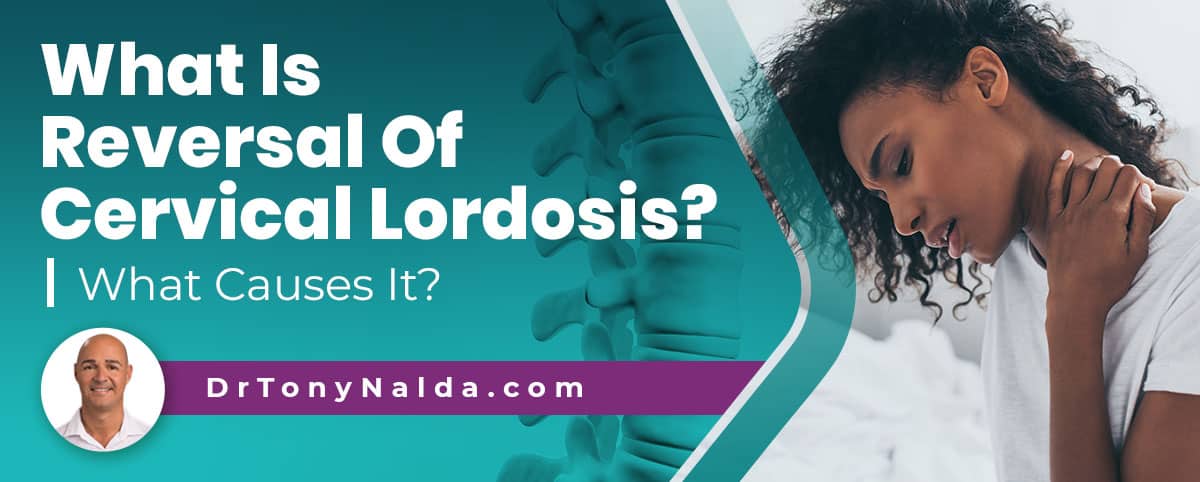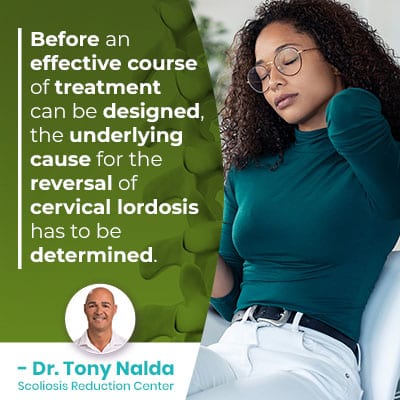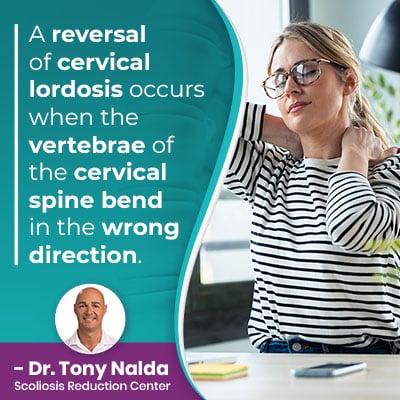What Is Reversal Of Cervical Lordosis? What Causes It?

When the spine loses a healthy curve, it impacts the health of its other curves and can disrupt the biomechanics of the entire spine. When there is a loss of cervical lordosis, the neck becomes excessively straight, disrupting its ability to support the weight of the head, and when there is a reversal of cervical lordosis, the neck becomes more kyphotic and lordotic.
Cervical lordosis refers to the neck’s natural inward curvature, and a reversal of cervical lordosis is when the cervical spine’s curve bends in the wrong direction. A reversal of cervical lordosis is associated with a number of causes that guide the design of effective treatment plans.
Understanding the role of the cervical spine is important, so let’s start with why it’s important to maintain a healthy degree of cervical lordosis.
The Cervical Spine
The neck plays a role in how many systems within the body function as it connects the brain to the rest of the body.
Spinal conditions can cause a wide range of symptoms felt throughout the body because the spine and brain work in tandem to form the body’s central nervous system (CNS) that facilitates brain-body communication.
Maintaining healthy brain-body communication is key to overall health because the central nervous system is in charge of relaying messages and signals to the body’s systems and organs.
The neck’s cervical spine is home to the first seven vertebrae of the spine, and when its curve is healthy, it’s shaped like a wide ‘C’, bending forward towards the body’s center.
The neck’s natural forward-facing curve is known as cervical lordosis, and it facilitates the cervical spine’s ability to support the weight of the head, while providing the neck with a wide range of motion.
Reversal of cervical lordosis can occur due to various factors, including moderate or severe scoliosis, and understanding the causes is essential for individuals who may need scoliosis braces and have concerns about sleeping with scoliosis.
So what does it mean to have a reversal of cervical lordosis?
What is a Reversal of Cervical Lordosis?
 At each level of the spine (cervical, thoracic, and lumbar), there is a natural range of curvature degree, with the degree of curve varying from person to person.
At each level of the spine (cervical, thoracic, and lumbar), there is a natural range of curvature degree, with the degree of curve varying from person to person.
If a person’s curvature degree falls beyond the normal range, that’s when problems can occur.
A natural and healthy range of cervical lordosis falls between 31 and 40 degrees, but as the cervical lordosis is lost, the neck starts to straighten out, interfering with how the cervical spine functions.
When the neck’s curve flattens out, this is referred to as military neck, commonly the result of hypolordosis, and when the curve of the cervical spine faces the wrong direction, this is considered a reversal of cervical lordosis or a reverse curve.
The spine’s natural and healthy curves make it stronger, more flexible, and better able to absorb stress, like a coiled spring, so when one of its healthy curves are lost, it doesn’t just affect that one spinal section. It disrupts the biomechanics of the entire spine as the health of each spinal curve is dependent on the others.
Reversal of cervical lordosis, can be caused by factors such as spinal degeneration, cervical spondylosis, or paraspinal muscle strain (ICD-10 code for paraspinal pain and paraspinal muscle strain ICD-10), and is often assessed through a cervical spine examination that may reveal issues at the C5-C6 level, affecting the cervical intervertebral discs and potentially requiring treatments like anterior cervical discectomy; this condition is also referenced as 'cuello lordosis cervical' in Spanish and can involve conditions like exaggerated lordosis of the cervical spine or levocurvature (ICD-10).
Reversal of cervical lordosis, also known as the straightening of the cervical lordosis, is a condition characterized by the abnormal flattening or straightening of the natural curve in the cervical spine. This curvature is typically described as a gentle C-shape curve, but in cases of reversal, it becomes less pronounced or even appears as a straight line.
Conditions such as forward head posture or dextrocurvature of the lumbar spine, leading to straightened lordosis and disrupted spinal alignment that can affect blood flow and overall spinal health as also connected to a reversal of cervical lordosis.
A reversal of cervical lordosis, can be caused by conditions like acute traumatic whiplash injury (ICD 10) or anterolisthesis (ICD 10), and this straightening of the cervical spine can be dangerous, potentially leading to complications in spinal curvature and affecting regions such as congenital spondylolisthesis and the sacral and sacrococcygeal region.
Reversal of cervical lordosis, hypecharacterized by a straight neck with no curve and often associated with cervical rlordosis, can be caused by factors like degenerative disc disease, potentially impacting the spinal cord and overall cervical curvature. Physical therapy may play a role in addressing this condition and restoring a healthy cervical spine alignment, differentiating it from a normal cervical lordosis.
Reversal of cervical lordosis prompts investigation into its causes, including factors like gradual lordosis progression. Understanding whether prominent straightening of the lordosis poses a danger is crucial in determining the need for interventions such as cervical kyphosis surgery, once diagnosed through appropriate diagnostic measures.
The condition is often associated with various factors, including poor posture, injury, or underlying medical conditions. The ICD-10 code for this condition is often used to document the "straightening of the normal cervical lordosis."
Reversal of cervical lordosis, a condition where the neck spine becomes curved in the opposite direction, can occur due to factors such as cervical muscle spasm (ICD 10), degenerative spondylolisthesis, and retrolisthesis of the vertebral body, potentially leading to limited body movement and loss of function.
It's important to note that while some degree of postural lordosis can be normal, an excessive or persistent straightening of the cervical lordosis can lead to discomfort and may require medical evaluation. Additionally, congenital kyphosis or issues in the lumbar region can sometimes contribute to the development of cervical lordosis abnormalities, highlighting the need for a comprehensive assessment to determine the underlying cause and appropriate treatment.
Before an effective course of treatment can be designed, the underlying cause for the reversal of cervical lordosis has to be determined.
What Causes Reversal of Cervical Lordosis?
There can be many causes for a loss of cervical lordosis, and it can also be caused by a combination of variables rather than being associated with a single clear source.
From accidents to injuries to chronic poor posture that involves constantly looking down at devices, the strain on the cervical spine, over time, can cause a host of neck issues.
The neck has to support the weight of the head, and if a person shifts their posture forward by as little as one inch at the cervical level, it can increase the weight of the head on the neck, shoulders, and surrounding muscles exponentially; this is known as forward head posture.
Over time, that extra weight can disrupt the spine’s natural alignment, causing tension headaches, neck pain, and tight and strained upper back/shoulder muscles.
There are also a variety of spinal conditions that are linked to a loss of cervical lordosis: hypolordosis, hyperlordosis, hyperkyphosis, osteoporosis, and scoliosis.
When the spine loses one or more of its healthy curves, the body responds by putting in unhealthy compensatory curves; for example, if a person develops hyperkyphosis of the lumbar spine (lower back), the cervical spine can respond with the development of a hyperlordotic curve in an attempt to counteract the unnatural spinal curve in the lumbar section.
Structural spinal conditions like scoliosis introduce a lot of uneven forces to the body and adverse spinal tension, and this causes unhealthy sideways spinal curves, with rotation, to develop, which can lead to a loss of cervical lordosis.
Conditions that are known to weaken the spine and increase risk of injury, such as osteoporosis, can cause compression fractures and intervertebral disc issues that interfere with the spine’s ability to maintain its natural curves and alignment.
If there is pre-existing damage to the ligaments of the spine or the spinal discs that’s caused by trauma, an accident, or an underlying condition, the spine is more vulnerable to losing its natural and healthy curves.
Reversal of cervical lordosis, also known as cervical kyphosis, can be confused with swayback posture, but it involves a distinct curvature alteration in the neck's spine. Understanding the differences between these conditions and their potential causes is crucial for proper diagnosis and management.
For those recently diagnosed with a reversal of cervical lordosis, how serious is the diagnosis?
Is Reversal of Cervical Lordosis Serious?
 The term lordosis refers to the inward curvatures of the spine that form a soft ‘C’ shape, while kyphosis is the opposite curvature type, bending outwards, away from the body’s center in a reverse ‘C’ shape.
The term lordosis refers to the inward curvatures of the spine that form a soft ‘C’ shape, while kyphosis is the opposite curvature type, bending outwards, away from the body’s center in a reverse ‘C’ shape.
A reversal of cervical lordosis occurs when the vertebrae of the cervical spine bend in the wrong direction.
The cervical spine has a natural range of lordosis, but if it starts to bend outwards (reversing), it’s becoming more kyphotic than lordotic.
Particularly if left untreated, it can cause a variety of issues, and symptoms will be case specific and depend on a variety of important factors such as patient age, causation, and severity.
A reversal of cervical lordosis is associated with the following symptoms:
- Neck/shoulder, and upper back pain
- Muscle pain
- Muscle spasms
- Numbness
- Tingling
- Nerve pain
- Limited range of motion in the neck
- Limited range of motion in the lower back (due to the development of a compensatory curve)
- Muscle-control issues
- Bladder-control issues
So, now that we have defined the condition and explored some of its symptoms, what are its treatment options?
How Do You Fix Loss of Cervical Lordosis?
There are a variety of approaches used to treat different spinal conditions, and here at the Scoliosis Reduction Center, I’ve treated a wide range of spinal conditions, including reversals of cervical lordosis.
I favor a chiropractic-centered conservative approach that integrates a number of treatment modalities for a truly customized approach with positive potential outcomes.
I approach patients, with a loss of cervical lordosis, with the goal of strengthening the neck’s muscles to improve the cervical spine’s range of motion, flexibility, and work towards improving the spine’s biomechanics; this can improve the overall spine’s health and allow it to function optimally.
First and foremost, when it comes to restoring a loss of cervical lordosis, the underlying cause of the loss has to be determined and shape the design of treatment plans.
If lifestyle factors such as chronic poor posture and/or carrying excess weight are part of the problem, I provide spine-friendly lifestyle guidance.
If a spinal trauma or injury has weakened the spine and contributed to the loss of cervical lordosis, the injury has to be addressed proactively to make improvements to cervical spine health.
When a spinal condition like osteoporosis, hypokyphosis, or scoliosis is the cause, the underlying condition has to be the guiding force of treatment. By impacting these conditions on a structural level, related symptoms are improved/alleviated as the vertebrae of the spine are manually adjusted back into alignment with the rest of the spine.
By combining chiropractic care, a variety of therapies, and condition-specific exercises, the treatment disciplines complement one another by relaxing strained muscles, repositioning vertebrae, and activating certain areas of the brain for improved posture, balance, and coordination.
The use of spinal weights has also proved particularly effective at neurological retraining and soft-tissue remodeling to focus on relaxing, restoring, and rehabilitating the neck’s ligaments for optimal spinal support and stabilization.
Taking an X-ray prior to the application of treatment and one at the completion of treatment is important so I can see how the spine has responded to treatment and confirm the cervical spine has been impacted structurally.
Conclusion
In order for the spine to function optimally, it needs to maintain its natural curves and alignment, but there are a variety of spinal conditions/issues that involve a loss of the spine’s natural and healthy curves.
Reversal of cervical lordosis, also known as flat back syndrome or straight back syndrome, can occur due to various factors, including conditions like levoconvex scoliosis, leading to an abnormal straightening of the neck's natural curvature.
Each section of the spine has a characteristic curvature type, and as the spine is one structure, the health of each section is dependent on the health of the others, which is why the loss of one spinal curve can disrupt the biomechanics of the entire spine.
A loss of cervical lordosis involves the neck becoming excessively straight, and a reversal of cervical lordosis occurs as the neck’s natural lordosis is replaced by excessive kyphosis: making it bend in the wrong direction.
Here at the Center, patients experiencing a reversal of cervical lordosis will be diagnosed, assessed, and treated proactively based on important factors such as patient age, condition severity, experienced symptoms, and causation.
Dr. Tony Nalda
DOCTOR OF CHIROPRACTIC
After receiving an undergraduate degree in psychology and his Doctorate of Chiropractic from Life University, Dr. Nalda settled in Celebration, Florida and proceeded to build one of Central Florida’s most successful chiropractic clinics.
His experience with patients suffering from scoliosis, and the confusion and frustration they faced, led him to seek a specialty in scoliosis care. In 2006 he completed his Intensive Care Certification from CLEAR Institute, a leading scoliosis educational and certification center.
About Dr. Tony Nalda
 Ready to explore scoliosis treatment? Contact Us Now
Ready to explore scoliosis treatment? Contact Us Now





